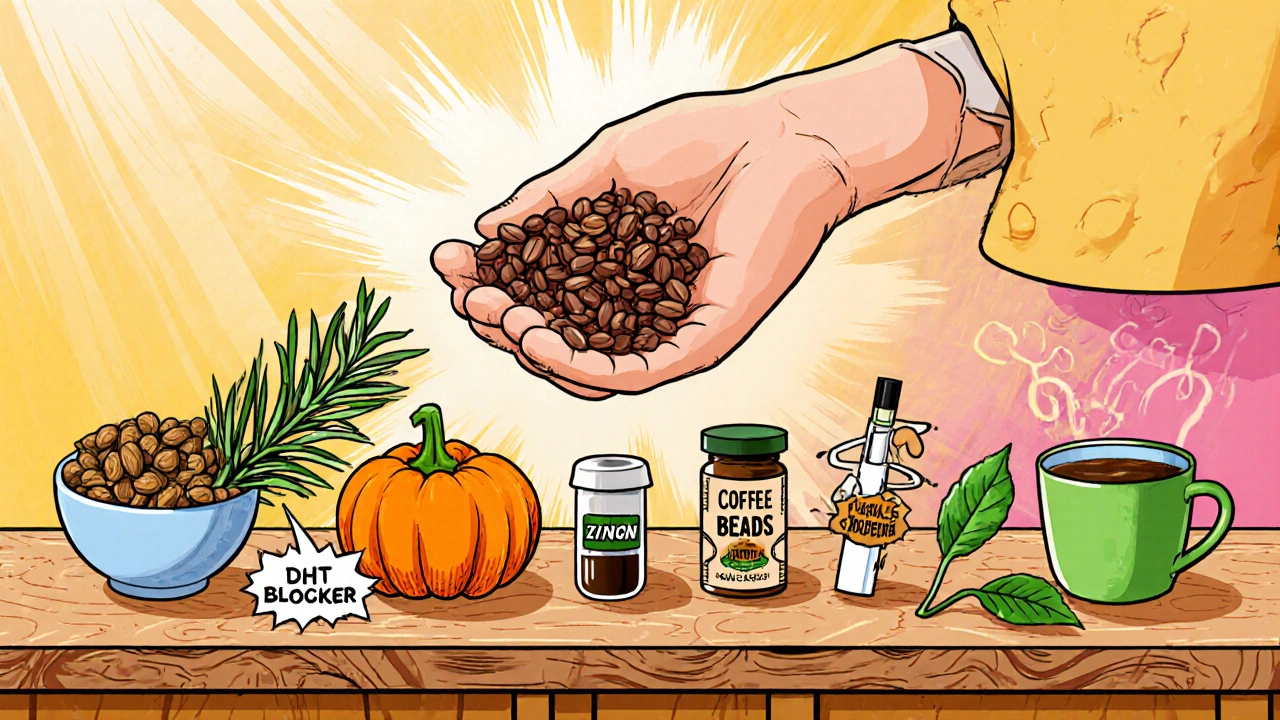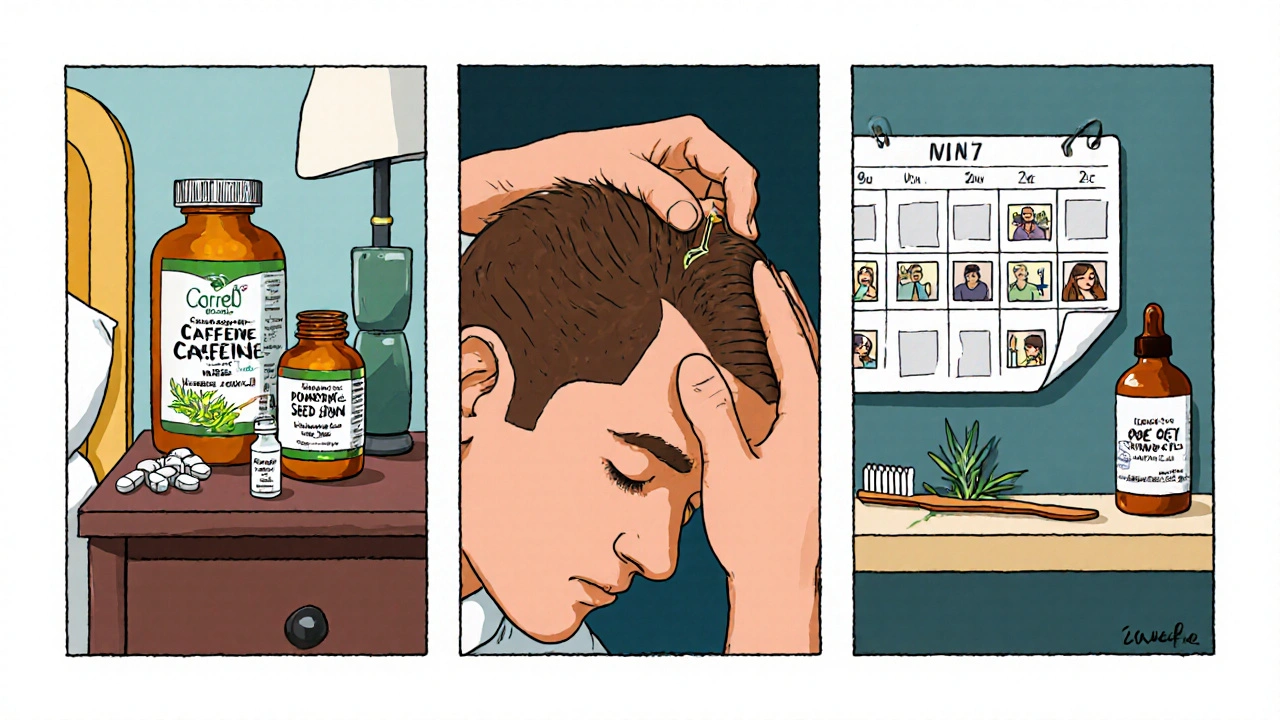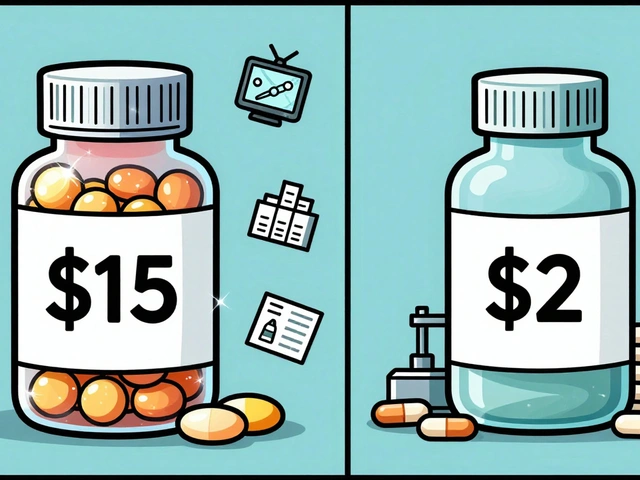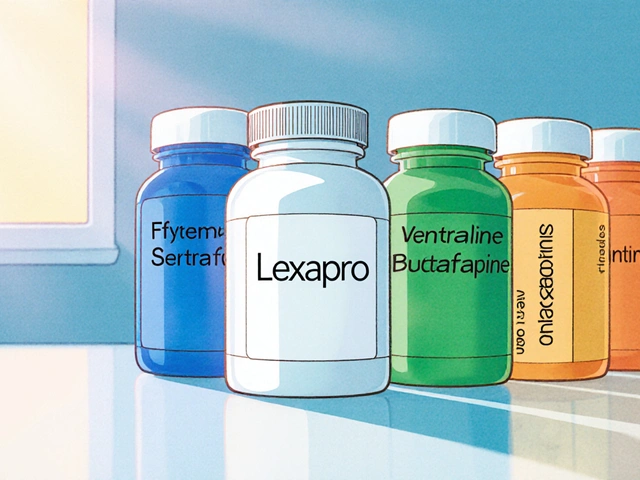Natural Hair Loss Remedy Comparison Tool
Compare Natural Hair Loss Treatments
Select your criteria to see which natural remedies are most suitable for your hair loss condition.
Remedy Comparison
| Remedy | Key Action | Evidence | Dosage | Time to See Results | Side Effects |
|---|
No remedies match your selected criteria. Try adjusting your filters.
When hair thins on the crown or temples, many people wonder if they have to rely on prescription drugs or pricey clinics. The answer isn’t always black‑and‑white. Below we break down the science behind Androgenic alopecia is a hereditary, hormone‑driven form of hair loss that affects both men and women. It’s triggered by an oversensitivity of hair follicles to dihydrotestosterone (DHT), a metabolite of testosterone. Over time, affected follicles shrink, produce finer strands, and eventually stop growing altogether.
Why DHT Is the Real Culprit
DHT binds to androgen receptors in the scalp’s dermal papilla cells. This interaction shortens the anagen (growth) phase and prolongs the telogen (resting) phase. The result: thinner hairs and slower regrowth. Understanding this pathway is key because most natural remedies aim to lower DHT levels locally, block its binding, or boost follicle health so they can resist the hormone’s effects.
What Counts as a Natural Remedy?
In the context of hair loss, a natural remedy is any plant‑derived extract, nutrient, or over‑the‑counter preparation that does not require a prescription and generally has a low side‑effect profile. These include herbs, oils, vitamins, and mineral supplements that have been studied for their anti‑DHT or follicle‑supporting properties.
Top‑Rated Natural Options and How They Work
-
Saw Palmetto is a berry extract that inhibits 5‑alpha‑reductase, the enzyme that converts testosterone into DHT. A 2022 double‑blind trial showed a 10‑12% reduction in scalp DHT after 12 weeks of 320 mg daily dosing.
-
Pumpkin Seed Oil contains phytosterols that compete with DHT for binding sites. In a randomized study of 76 men, 2 ml of oil taken twice daily increased hair counts by 40% over six months.
-
Rosemary Oil has antioxidant and anti‑inflammatory compounds that improve scalp circulation. A 2015 head‑to‑head comparison found rosemary oil applied twice daily was as effective as 2% minoxidil after six months.
-
Caffeine Shampoo penetrates the follicle and counteracts DHT‑induced shrinkage. In vitro studies show caffeine can extend the anagen phase by up to 30%.
-
Biotin (vitamin B7) supports keratin production. Deficiency is linked to brittle hair, and supplementation of 5 mg daily has been associated with modest density gains in a small cohort of female patients.
-
Zinc helps regulate hormonal balance and can inhibit 5‑alpha‑reductase activity. A 2021 meta‑analysis highlighted that 30 mg of elemental zinc per day improved hair thickness in 70% of participants with low baseline levels.
-
Green Tea Extract (epigallocatechin‑gallate) reduces DHT synthesis and provides antioxidant protection. Animal models demonstrate a 25% slowdown in follicle miniaturization.

Evidence Snapshot: How Strong Is the Research?
| Remedy | Study Design | Key Outcome | Typical Dosage | Common Side Effects |
|---|---|---|---|---|
| Saw Palmetto | Randomized, double‑blind, 12 weeks | 10‑12% scalp DHT drop, modest hair‑count rise | 320 mg daily | Mild GI upset |
| Pumpkin Seed Oil | Placebo‑controlled, 6 months | 40% increase in hair count | 2 ml twice daily | None reported |
| Rosemary Oil | Parallel, 6 months | Comparable to 2% minoxidil | 5% solution, twice daily | Scalp irritation (rare) |
| Caffeine Shampoo | In‑vitro, human follicles | 30% longer anagen phase | Standard 2‑times‑weekly wash | None |
| Biotin | Open‑label, 3 months | Improved thickness in 30% of users | 5 mg daily | Rare acne flare‑up |
| Zinc | Meta‑analysis of 8 RCTs | 70% showed thicker strands | 30 mg elemental daily | Metallic taste, nausea |
| Green Tea Extract | Animal study, 12 weeks | 25% slower follicle miniaturization | 300 mg EGCG daily | Stomach upset (high dose) |
Putting It All Together: A Practical Routine
- Start with a DHT‑blocking supplement: Saw Palmetto 320 mg in the morning and Pumpkin Seed Oil 2 ml with lunch.
- Add scalp‑care: Massage a few drops of 5% Rosemary Oil diluted in carrier oil (e.g., jojoba) into the hairline each night.
- Wash with a Caffeine Shampoo twice a week to keep follicles energized.
- Support overall hair health with a daily multivitamin that includes Biotin 5 mg, Zinc 30 mg, and Vitamin D 2000 IU (low vitamin D is linked to increased hair shedding).
- Monitor progress with photos every four weeks. Give any regimen at least 12 weeks before judging effectiveness.
Consistency is the biggest predictor of success. Skipping days or switching products every week dilutes the hormonal impact you’re trying to counteract.
When Natural Isn’t Enough
If you notice rapid thinning, bald patches larger than a quarter inch, or if the scalp feels itchy and inflamed, it’s time to see a dermatologist. Prescription‑grade Finasteride (1 mg daily) and Minoxidil (2% or 5% topical) have robust FDA‑approved data that can halt progression far more reliably than herbs alone.
That doesn’t mean you must abandon natural options. Many clinicians recommend a combined approach: a low‑dose finasteride plus a daily saw palmetto supplement, for example. This stacks the anti‑DHT effect while keeping side‑effects minimal.

Common Pitfalls and How to Avoid Them
- **Choosing low‑quality extracts** - Look for third‑party testing (e.g., USP or NSF) to ensure the product contains the promised amount of active compounds.
- **Over‑supplementing** - More isn’t always better. Excess zinc can impair copper absorption, leading to new hair problems.
- **Ignoring lifestyle factors** - Stress, poor sleep, and a high‑sugar diet amplify DHT production. Pair your regimen with regular exercise and a balanced diet.
Quick Takeaway Checklist
- Identify if your pattern matches androgenic alopecia (gradual thinning at crown/temples).
- Start with clinically studied natural agents: saw palmetto, pumpkin seed oil, rosemary oil.
- Combine with a caffeine shampoo and a balanced micronutrient blend.
- Track results with photos; give it 3‑4 months.
- Consult a dermatologist if loss accelerates or you need a stronger medical boost.
Frequently Asked Questions
Can natural remedies completely replace finasteride?
Most studies show natural agents can slow hair loss and add modest density, but they rarely match the 70‑90% efficacy of finasteride for advanced cases. Using them together often yields the best balance of benefit and side‑effect risk.
How long before I see results?
Hair cycles are slow. Expect visible changes after 12‑16 weeks of consistent use. Some users report earlier improvements in scalp itching or shine.
Are there any safety concerns with rosemary oil?
Pure rosemary oil can irritate sensitive skin. Dilute it to a 5% solution (5 ml rosemary oil in 95 ml carrier) and do a patch test before full application.
Do I need a blood test before taking zinc?
If you have no known deficiency, a standard 30 mg daily dose is safe for most adults. People with chronic kidney disease should check with a doctor first.
Can women use these remedies safely?
Yes. Women benefit especially from biotin, zinc, and rosemary oil. Saw palmetto is hormonally active, so start with a lower dose (160 mg) and monitor any changes in menstrual patterns.





Kyle Garrity
Hey, I totally get how frustrating it can be when you notice the thinning spots creeping in. I’ve tried a few of the natural combos myself and the key is staying consistent – missing a week really sets you back. Saw palmetto and pumpkin seed oil together seemed to give my scalp a bit of a boost after a couple of months. Also, don't forget to keep an eye on your diet; protein and healthy fats make a difference. If you’re patient and track the progress with photos, you’ll have a clearer picture of what’s actually working.
brandon lee
Not a fan of fancy stuff just stick to the basics and you’ll see some change.
Joshua Pisueña
Yo, the DHT blockers are legit if you give them time – no overnight miracles. Mix the saw palmetto with a good rosemary oil scalp massage and you’ll keep the follicles happy. Just remember not to go overboard; a little consistency beats a big binge every now and then. Keep the vibe chill and let the science do its thing.
bill bevilacqua
Well, look at this, another "miracle" post…,,; the internet is full of hype!!! People love to push pills that do zip‑zap on their wallets, and then they blame the “natural” stuff for not delivering!!! Honestly, if you want results, stop chasing snake‑oil and read a real study,,; the data isn’t pretty but it’s there!!
Ralph Barcelos de Azevedo
It’s troubling to see pseudo‑science masquerading as a cure, especially when people’s self‑esteem hangs in the balance. While I acknowledge the desire for gentler alternatives, we must not sideline proven treatments without solid evidence. The moral imperative is to present balanced information, not hype unverified claims. Let’s keep the conversation rooted in rigor and compassion.
Peter Rupar
Honestly, it’s like these “natural” remedies are just a fancy excuse for lazy people to avoid real medicine. People definately need to stop fooling themselves and realize that if you want actual results you gotta take something that works – not this mushy plant juice nonsense. Stop whining and get your head out of the sand and into a real dermatologist’s office.
Nikita Shue
Listen up – if you’re serious about turning the tide on hair loss, commit to the routine as if it’s a daily workout. Saw palmetto in the morning, pumpkin seed oil at lunch, and a rosemary scalp massage before bed. No shortcuts, just a solid plan. Stick with it for a full three months and you’ll see that the hair isn’t just a myth.
Heather McCormick
Wow, another “well‑researched” list… because we all know the internet never lies. Sure, the studies sound nice on paper, but have you actually seen a miracle? Probably not, unless you count the miracle of buying more supplements. Good luck convincing anyone that a few drops of oil will outrun a proven prescription.
Robert Urban
Hey folks, let’s keep the tone friendly. I think there’s room for both natural approaches and medical ones – it’s not an either/or scenario. If someone’s comfortable with supplements, that’s cool; if they need a prescription, that’s fine too. Respect each path and share what truly helped you.
Grace Baxter
Honestly, I find it amusing that everyone jumps on the bandwagon of “natural” remedies as if they’re some panacea. The premise that a handful of herbs can out‑perform decades of pharmaceutical research is, frankly, a delusion cultivated by marketing hype. While I respect individual choices, we must not overlook the fact that many of these studies are under‑powered, short‑term, and sometimes funded by the very companies selling the supplements. Moreover, the variability in extraction methods means that one “saw palmetto” capsule could be nothing more than a placebo. It’s also worth noting that the androgenic pathways are complex, and simply blocking DHT locally does not address upstream hormonal imbalances. In addition, excessive zinc supplementation can lead to copper deficiency, which in turn may cause hair loss of a different kind. The dopamine‑driven consumerism in the wellness industry often exploits the desperation of those experiencing hair thinning. Let’s not forget that the “natural” label is not synonymous with “safe” – some individuals experience dermatitis from rosemary oil or gastrointestinal upset from high‑dose phytosterols. While I’m not condemning the entire category, I argue that relegating proven treatments to a secondary status is scientifically irresponsible. If you truly desire evidence‑based outcomes, consider consulting a dermatologist who can tailor a regimen, possibly integrating proven pharmacologic agents with any adjunctive natural products you prefer. This balanced, personalized approach respects both the art and the science of hair restoration. In short, enthusiasm for natural solutions should be tempered by critical appraisal, not blind faith.
Rob Flores
Ah, the noble quest for the “perfect” hair regimen – as if the internet were a peer‑reviewed journal. One might as well sip artisanal coffee while waiting for follicular miracles. Cheers to the endless scroll of pseudo‑science.
Shiv Kumar
In the grand tapestry of trichology, one must discern between empirical rigor and romanticized folklore. While interdisciplinary curiosity is commendable, let us not conflate anecdotal reverie with methodical validation. A measured synthesis of evidence remains the cornerstone of effective practice.
Eddie Mark
Picture this: a sunrise over a quiet scalp, the gentle hum of rosemary oils dancing like fireflies – pure drama, right? Yet underneath the poetic swirl lies a simple truth: consistency beats occasional extravagance every single time.